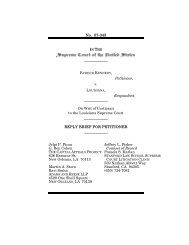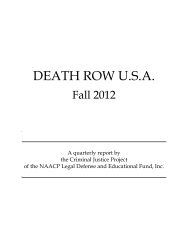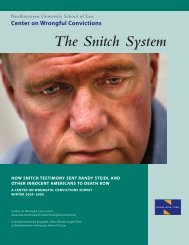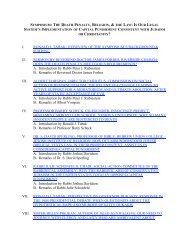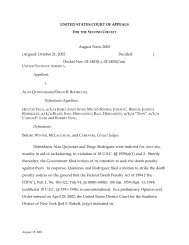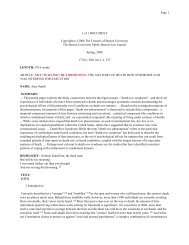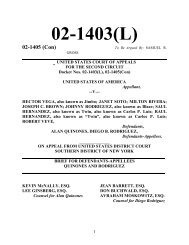Testimony of Richard C. Dieter, Executive Director, Death
Testimony of Richard C. Dieter, Executive Director, Death
Testimony of Richard C. Dieter, Executive Director, Death
Create successful ePaper yourself
Turn your PDF publications into a flip-book with our unique Google optimized e-Paper software.
Joint Committee on Criminal JusticeLegislature <strong>of</strong> MassachusettsBoston, Massachusetts<strong>Testimony</strong> <strong>of</strong><strong>Richard</strong> C. <strong>Dieter</strong><strong>Executive</strong> <strong>Director</strong><strong>Death</strong> Penalty Information Center"The Costs <strong>of</strong> the <strong>Death</strong> Penalty"March 27, 2003
Costs <strong>of</strong> the <strong>Death</strong> Penalty page 2INTRODUCTIONGood morning. Mr. Chairman, and Members <strong>of</strong> the Committee. I want to thank youfor this opportunity to appear before you and to <strong>of</strong>fer my remarks on the costs <strong>of</strong> thedeath penalty.My name is <strong>Richard</strong> <strong>Dieter</strong> and I am the <strong>Executive</strong> <strong>Director</strong> <strong>of</strong> the <strong>Death</strong> PenaltyInformation Center in Washington, DC, a position I have held for the past 10 years. Iam also an attorney and an adjunct pr<strong>of</strong>essor at Catholic University Law School. The<strong>Death</strong> Penalty Information Center is a non-pr<strong>of</strong>it organization whose focus is researchand analysis <strong>of</strong> capital punishment.There are many controversial aspects to the death penalty debate and the question <strong>of</strong>costs <strong>of</strong>ten gets overlooked. Fiscal considerations, however, are important in their ownright, and they have a critical impact on other aspects <strong>of</strong> this discussion.Talk about the death penalty is really about the safety <strong>of</strong> the community. There aremany ways to make the community safer, and most <strong>of</strong> these have costs associated withthem. As legislators, you are keenly aware that there is no bottomless pot <strong>of</strong>government money to be spent on things that might help the community. The moreyou spend on one project, the less there is available for other worthwhile endeavors.All <strong>of</strong> the studies regarding the cost <strong>of</strong> the death penalty have concluded that itamounts to a net expense to the state and the taxpayers. Hence, it must be paid for bysacrificing other projects. Or to put it another way, the extra money spent on the deathpenalty could be spent on other means <strong>of</strong> making the community safer: better lightingin crime areas, more police on the streets, perhaps longer periods <strong>of</strong> incarceration forsome <strong>of</strong>fenders, or projects to reduce unemployment. Quite a few jurisdictions withthe death penalty have recently had to cut back on other vital services. In some states,people are being released from prison early as a cost saving measure.
Costs <strong>of</strong> the <strong>Death</strong> Penalty page 3Moreover, the costs <strong>of</strong> the death penalty are central because they play a key role inhow the death penalty is implemented. Supporters and opponents <strong>of</strong> the death penaltyagree that a system <strong>of</strong> capital punishment should not take unnecessary risks withinnocent lives and should be applied with a strict sense <strong>of</strong> fairness. As with manythings, the death penalty on the cheap is really no bargain. There is no abstract dollarfigure for the cost <strong>of</strong> the death penalty -- it depends on the quality <strong>of</strong> the system youdemand. In Illinois, their system was fraught with error. Over a 20-year period, theyfreed more innocent people from death row than they executed. As a result, a blueribboncommission there recommended 85 changes to make the death penalty morereliable; most <strong>of</strong> them will now cost the state even more money. 1There is little dispute about the fact that the death penalty is expensive. Of course,sentencing someone to life in prison is also very expensive. <strong>Death</strong> penalty costs tend tobe experienced up-front, especially at trial and for the early appeals. Life-in-prison costsare drawn out over many decades.But the most expensive system would be one which combines the most costly parts <strong>of</strong>both punishments: lengthy and complicated death penalty trials followed byincarceration for life. Surprisingly, research has shown that the most expensive systemis exactly what you can expect from the death penalty. In most cases, where the deathpenalty is sought, it is never imposed. And even when it is imposed, it is rarely carriedout.<strong>Death</strong> penalty cases are clearly more expensive in the early stages. Everything that isneeded for an ordinary trial is needed for a death penalty case, only more so:• more pre-trial time will be needed to prepare: cases typically take a year to come totrial1. Report <strong>of</strong> the Governor's Commission on Capital Punishment (Illinois, released April 15, 2002).
Costs <strong>of</strong> the <strong>Death</strong> Penalty page 4• more pre-trial motions will be filed and answered• more experts will be hired• twice as many attorneys will be appointed for the defense, and a comparable teamfor the prosecution• jurors will have to be individually quizzed on their views about the death penalty• they are more likely to be sequestered• two trials instead <strong>of</strong> one will be conducted: one for guilt and one for punishment• the trial will be longer: a cost study at Duke University estimated that death penaltytrials take 3 to 5 times longer than typical murder trials• and then will come a series <strong>of</strong> appeals during which the inmates are held in the highsecurity <strong>of</strong> death row.It is only after an execution that a death penalty case costs less than a non-death penaltycase. However, few capital cases result in execution, so the "savings" disappear. Arecent study at Columbia University Law School found that 68% <strong>of</strong> death penalty casesare overturned on appeal. 2 Either the conviction or the sentence is found to haveserious error requiring it to be done over. When these death penalty cases are given asecond hearing, approximately 82% result in a life sentence. Thus, the typical deathpenalty case has all the expenses <strong>of</strong> its early stages and appeal; it is then overturned,and a life sentence is imposed, resulting in all the costs <strong>of</strong> 30 to 40 years <strong>of</strong> incarceration.Only about 11% <strong>of</strong> people who have been sentenced to death have been executed. 32. James S. Liebman, "A Broken System: Error Rates in Capital Cases," (Columbia Univ. June, 2000)(<strong>Executive</strong> Summary).3. See Bureau <strong>of</strong> Justice Statistics, "Capital Punishment 2001," appendix Table 3 (2002).
Costs <strong>of</strong> the <strong>Death</strong> Penalty page 5Perhaps if Massachusetts had the death penalty it would be more efficient. Texas, forexample, has executed about one-third <strong>of</strong> the people it has sentenced to death. Even atthat rate, it has been estimated that the extra costs <strong>of</strong> the death penalty in Texas areabout $2.3 million per case. 4Massachusetts' history with executions indicates that the numbers here would likely befar smaller than in Texas. During the entire 20th century, when the death penalty wasmuch less controversial, Massachusetts executed about 65 people, or less than oneperson per year.If Massachusetts adopted the death penalty, I suspect their experience would be morelike New York's. New York reinstated the death penalty almost 8 years ago. Theycurrently have 5 people on death row and no executions. Here are some <strong>of</strong> theirexpenses so far, realizing that they are still many years, if ever, away from their firstexecution:• Since 1995, New York has spent $68.4 million for defense <strong>of</strong> 702 defendants chargedwith crimes that might warrant the death penalty.• The Queens District Attorney's Office estimates that seeking the death penaltytranslates into 300% to 500% more work than for a non-capital murder trial.• The lead appellate attorney for the Brooklyn District Attorney's <strong>of</strong>fice spent morethan 600 hours <strong>of</strong> time on state's first "successful" capital case, that <strong>of</strong> Darrel Harris.• During the preparation <strong>of</strong> its 1,181-page brief for the Harris case, the BrooklynDistrict Attorney's <strong>of</strong>fice was assisted by prosecutors in 8 other counties.• The defense team for Harris spent approximately $1.7 million to mount his defense,and the state's Capital Defender Office invested $1.2 million into producing theteam's 779-page brief. 54 . C. Hoppe, "Executions Cost Texas Millions," Dallas Morning News, March 8, 1992, at 1A.5. New York Law Journal, April 30, 2002.
Costs <strong>of</strong> the <strong>Death</strong> Penalty page 6The end result <strong>of</strong> the Harris case is that his sentence was overturned and he has beenresentenced to life in prison with no parole. If the death penalty had not been sought,all the extra expenses associated with the death penalty could have been avoided, andthe result would have been exactly the same.By the way, I should point out that since 1995, when New York adopted the deathpenalty, the murder rate in Massachusetts has dropped 36% without the death penalty.COST STUDIESIt turns out to be relatively difficult to put a precise cost on the death penalty: it is liketrying to put a dollar figure on heart disease -- it is easy to state the question, butcomplicated to answer. Nevertheless, there have been some studies by governmentagencies, newspapers, and independent researchers that create a clearer picture.The studies differ widely in the states they cover, in their level <strong>of</strong> sophistication and inthe assumptions they make. However, they have all come to the same conclusion, andmany <strong>of</strong> their estimates <strong>of</strong> the costs are fairly similar.COMMON PARAMETERS OF THE STUDIESMost <strong>of</strong> these studies do not simply look at the costs <strong>of</strong> an isolated case. Rather the bestanalyses compare a system in which the death penalty is employed to a system dealingwith similar crimes in which a life sentence is the most severe punishment allowed. Atevery step <strong>of</strong> the analysis, the question is asked: how much more, or less, does thesystem with the death penalty cost compared to the other system?One important point about the better cost studies: many <strong>of</strong> the costs <strong>of</strong> the deathpenalty do not appear as line items in the budget. It is not accurate to say that the timespent by the prosecution, by the judges, and even in some instances by the defense,could be calculated as no expense because, if these participants weren’t doing deathpenalty cases, they would still have to be paid the same. This ignores what the studies
Costs <strong>of</strong> the <strong>Death</strong> Penalty page 7call “opportunity costs.” Time is money. If a prosecutor or judge works longer on acase because it is a death penalty case, then those hours are not available for otherwork. The same is true for the judge’s staff, and even for the square feet <strong>of</strong> thecourtroom used for the trial. If death penalty cases take more time, then that timedifference is a net cost measured in the hours <strong>of</strong> all the participants.HOW MUCH DOES THE DEATH PENALTY COST?The major cost studies on the death penalty all indicate that it is much more expensivethan a system where the most severe sentence is life in prison:⇒The most comprehensive study conducted in this country found that the deathpenalty costs North Carolina $2.16 million per execution over the costs <strong>of</strong> a nondeathpenalty system imposing a maximum sentence <strong>of</strong> imprisonment for life. 6These findings are sensitive to the number <strong>of</strong> executions the state carries out.However, the authors noted that even if the death penalty was 100% efficient, i.e., ifevery death sentence resulted in an execution, the extra costs to the taxpayers wouldstill be $216,000 per execution.⇒Some years ago, the Miami Herald estimated that the costs <strong>of</strong> the death penalty inFlorida were $3.2 million per execution, based on the rate <strong>of</strong> executions at that time. 7Florida's death penalty system has bogged down for a number <strong>of</strong> reasons, includinga controversy over the electric chair. As a result, a more recent estimate <strong>of</strong> the costsin Florida by the Palm Beach Post found a much higher cost per execution: Floridaspends $51 million a year above and beyond what it would cost to punish all firstdegreemurderers with life in prison without parole. Based on the 44 executionsFlorida had carried out from 1976 to 2000, that amounts to a cost <strong>of</strong> $24 million foreach execution. 86 . P. Cook, "The Costs <strong>of</strong> Processing Murder Cases in North Carolina," Duke University (May 1993).7 . D. Von Drehle, "Bottom Line: Life in Prison One-sixth as Expensive," The Miami Herald, July 10,1988, at 12A.8 . S. V. Date, "The High Price <strong>of</strong> Killing Killers," Palm Beach Post, Jan. 4, 2000, at 1A.
Costs <strong>of</strong> the <strong>Death</strong> Penalty page 8⇒In Texas, the Dallas Morning News concluded that a death penalty case costs anaverage <strong>of</strong> $2.3 million, about three times the cost <strong>of</strong> imprisoning someone in asingle cell at the highest security level for 40 years. 9⇒The Sacramento Bee found that the death penalty costs California $90 millionannually beyond the ordinary costs <strong>of</strong> the justice system - $78 million <strong>of</strong> that total isincurred at the trial level. 10 Since California has averaged much less than oneexecution per year, the costs per execution are astronomical, approaching $100million per execution. Recently, the governor <strong>of</strong> California requested an additional$220 million from the legislature to construct a new death row.⇒A recent study by Indiana's Criminal Law Study Commission found that thetotal costs <strong>of</strong> the death penalty projected into the future for the state's current capitalcases would be about $51 million, exceeding the future costs <strong>of</strong> life without parolesentences by about 38%. 11In a report from the Judicial Conference <strong>of</strong> the United States on the costs <strong>of</strong> the federaldeath penalty, it was reported that defense costs were about 4 times higher in caseswhere death was sought than in comparable cases where death was not sought.Moreover, the prosecution costs in death cases were 67% higher than the defense costs,even before including the investigative costs <strong>of</strong> law enforcement agencies. 129. C. Hoppe, "Executions Cost Texas Millions," Dallas Morning News, March 8, 1992, at 1A.10. S. Maganini, "Closing <strong>Death</strong> Row Would Save State $90 Million a Year," Sacramento Bee, March28, 1988, at 1.11. Indiana Criminal Law Study Commission, January 10, 2002 (assuming that only a modest 20% <strong>of</strong>death sentences are overturned and resentenced to life).12. See, "Federal <strong>Death</strong> Penalty Cases: Recommendations Concerning the Cost and Quality <strong>of</strong> DefenseRepresentation," Judicial Conference <strong>of</strong> the United States (May 1998).
Costs <strong>of</strong> the <strong>Death</strong> Penalty page 9A recent article in the Wall Street Journal noted that in states where counties are chieflyresponsible for prosecuting capital cases, the expenses can put an extraordinary burdenon local budgets, comparable to that caused by a natural disaster. 13 Katherine Baicker<strong>of</strong> Dartmouth concluded that capital cases have a "large negative shock" on countybudgets, <strong>of</strong>ten requiring an increase in taxes. She estimated the extra expenses oncounties to be $1.6 billion over a 15-year period. 14The net effect <strong>of</strong> this burden on counties is a widely disparate and somewhat arbitraryuse <strong>of</strong> the death penalty. "Rich" counties that can afford the high costs <strong>of</strong> the deathpenalty may seek this punishment <strong>of</strong>ten, while poorer counties may never seek it at all,settling for life sentences instead. In some areas, this geographical disparity can haveracial effects, as well, depending on the geographical location <strong>of</strong> racial minorities withinthe state.Even counties that do pursue capital cases have found that they have had to cut back onother services such as libraries, ambulances, or even patrol cars for the police. Somecounties have approached the brink <strong>of</strong> bankruptcy because <strong>of</strong> one death penalty casethat has to be done over a second or third time. 15Many <strong>of</strong> the costs <strong>of</strong> the death penalty are inescapable and have likely increased evensince the studies mentioned here were conducted, as the demands for a more reliableand fairer system are heard. The appeals process is now longer, the defense attorneys,the prosecutors and the judges all cost more per hour, the re-trials are long and moreexpensive. The majority <strong>of</strong> the costs occur at the trial level, and cannot easily bestreamlined or reduced.13 . R. Gold, "Counties Struggle with High Cost <strong>of</strong> Prosecuting <strong>Death</strong>-Penalty Cases," Wall St. Journal,Jan. 9, 2002.14. K. Baicker, "The Budgetary Repercussions <strong>of</strong> Capital Convictions," National Bureau <strong>of</strong> EconomicResearch, Working Paper 8382, July 2001.15. See generally, R. <strong>Dieter</strong>, "Millions Misspent: What Politicians Don't Say About the High Costs <strong>of</strong>the <strong>Death</strong> Penalty," (revised edit., 1994) (available from the <strong>Death</strong> Penalty Information Center).
Costs <strong>of</strong> the <strong>Death</strong> Penalty page 10The death penalty absorbs huge amounts <strong>of</strong> money. Millions <strong>of</strong> dollars are spent on afew people with almost no control over the outcome. It is true that you cannot put aprice on justice. But you can put a price on more police on the streets, better lighting incrime areas, job and education programs, or even prison cells. A state has to choosewhere to put its limited resources.Thank you for this opportunity. I would welcome any questions the Committee mayhave.




